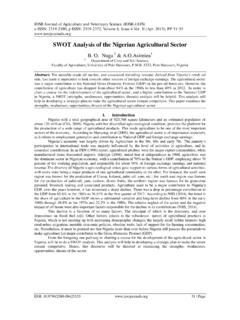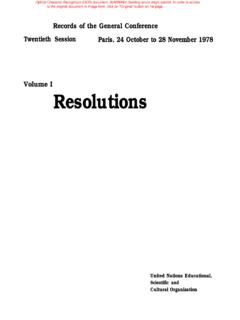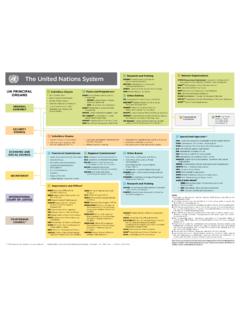Transcription of Benefits of Participation in Sport to the Youth
1 IOSR Journal of sports and Physical Education (IOSR-JSPE) e-ISSN: 2347-6737, p-ISSN: 2347-6745, Volume 4, Issue 1, (Jan. Feb. 2017), PP 30-34 DOI: 30 | Page Benefits of Participation in Sport to the Youth Olanipekun Johnson Adetunji, , Akindutire, Isaac Olusola, 1,2 Department of Human Kinetics and Health Education, Faculty of Education, Ekiti State University, Ado-Ekiti, Nigeria. Abstract: Boosting Participation in Sport can generate variety of profound and positive impact on socio-economic and health Benefits on individual, community and wider society. Regardless of age groups, being physically active can help individuals enjoy physical fitness towards wellness and live healthier lives. This paper therefore, highlighted the concept of Sport , characteristics and its types. It focused on the forms of Sport programmes and the Benefits of Sport Participation among Youth .
2 Issues related to the threats against active Sport Participation among Youth and strategies for advancing the level of Sport technology development in African continent were discussed. Towards the Benefits of effective Participation in sports among the Youth , it was therefore, recommended that Sport personnel including physical education teachers must be qualified, competent, and seasoned as prerequisites for a successful Sport programme. The various post-primary schools and tertiary institutions should survey and explore other feasible sources of raising funds from Sport ministries, philanthropists, voluntary agencies, and multinational companies to supplement the students sports fees; and adequate good quality Sport facility, durable equipment and supplies should be provided with incentives to motivate athletes. Keyword: Sport , strategies, Youth , Sport programmes, Benefits , threats. I. Introduction It is a difficult task to identify the real concept of Sport because of the diverse meaning it portray to peoples at different levels and different occasion sports , all over the world has become an established entity that exert great influence on social, political and even the economic environments of any nation and that of individuals.
3 The Oxford Dictionary (1990) defined sports as an activity engaged in especially outdoor for amusement and exercise, while Mbaye (1999) defined sports to be a group of physical exercises that may be organized into individual or team games with one specific rule. Sport is a general name that is used when one is referring to activities requiring competition between two or more people (Ajisafe, 2009; Mangan, 2011). It is one of the major components of Human Kinetics (Physical Education) with athletics, gymnastics, dance, swimming, wrestling, cycling and games. Sport are stabilizing factor that keeps participants against dangers of modern civilization which are now prevalent in different societies. Experience has shown that Sport can achieve what it takes peace talk, diplomatic treaties and conferences a longer period to achieve. For instance, it is only sports that could, in a short time bring warring nations together the Jews and the Arabs, England and Argentina, Ghana and Togo to list a few.
4 Considering the Olympic standard, sports is best described as a game of occurrence, an institutionalized game, as a social institution and as a social system (Coakley, 1982). This portrays Sport as an activity that is competitive in nature, having both intrinsic and extrinsic motivations, while any activities that do not fall within the domain of the definition could be termed as recreation or play. It is a stabilizing factor that keeps the participants against dangers of modern civilization which are now prevalent in different societies. It serves as safety valve for both participants for both participants and spectators dissipating excess energy, tension and hostile feelings in socially acceptable way. Sport is organized or unorganized recreation. Today, Sport is by nature, is competitive, following the rules and regulations and beneficial to both who are physically able and disabled.
5 It is selective for the disabled and for this reason, majority of students are excluded from Participation in the schools. Less able students tend to become the passive participants who just stand to hail the good performances of their mates. Sport is used as a leisure activity in hunting or fishing wildlife for entertainment rather than for subsistence or for the market. II. Characteristics Of Sport Sport has so many features that make it what it is today. For any activity to qualify or be regarded as Sport , it must be competitive in nature because people struggle to win, using their knowledge, skills and techniques required for performing them. It is educative because it involves teaching/coaching and learning. It has specific rules and regulations guiding them. It is recreational in nature because it enables people to take part when they like and for entertainment for both the participants and spectators watching such performance; and it is performed as an individual activity, dual and team activity (Loy, 1968; Payne, 1990).
6 Benefits of Participation in Sport to the Youth DOI: 31 | Page III. Types Of Sport There are various types of Sport that are called Sport . The major types of Sport are outdoor Sport , indoor Sport , physical development Sport and mental development Sport (Ojeme and Uti, 1996). These sports may include any of the following: 1. Aquatic Sport that take place in water such as swimming, diving, water polo, synchronize, swimming, rowing canoeing etc. 2. Combating Sport that requires the use of force on one s opponents such as boxing, wrestling, judo, karate, and taekwondo. 3. Athletics Sport that consist of all tracks and field like short and fast distance races, middle distance races, long distance races, hurdles, the throws, the jumps and the vaults. 4. Games as organized competitive activities involving movement skills and played according to the rules and regulations All African games, Nigerian University Games (NUGA), Nigerian Colleges of Education Games (NICEGA), Nigerian Polytechnics Games (NIPOGA) Games Olympic Games and West African University Games (WAUG).
7 All major games may include the ball games, racket/striking games while the minor games are table soccer, billiards darting and fencing etc. 5. Gymnastics as a Sport involving performance of exercises requiring physical strength, flexibility, agility, coordination, balance and grace (Babalola, 2010). The various forms of gymnastics include artistic gymnastics, (balancing on the beam), vaults, parallel bars, floor exercises, use of rings, trampoline and tumbling, aerobic and aerobatic gymnastics, team gymnastics and rope climbing. 6. Recreational Sport are movements activities performed during free or leisure hours or time such as horse racing, game shooting, polo game, table tennis, kite flying, ball games running jogging, Ayo game and other traditional or local games and sports . Traditional sports are sporting activities of different cultures of any country involving traditional wrestling, Ayo game/Aarin (pebble).
8 IV. Forms Of Sport Programmes Sport programmes may be in form of intramural sports (intramurals) and extramural sports programmes. Intramurals Intramural sports are recreational sports organized within a particular institution, usually an educational institution or a set of geographical area (Ladani, 2007). This is used to indicate Sport matches and contests that take place among teams from within the walls of an ancient city (as opposes to varsity team which competed with the team from other cities or towns. As extension of regular class periods of physical education, intramural sports are those activities that are conducted within the four walls of an educational institution or establishment. Only bonafide students of that institution can take part in the activities). The purpose of intramural Sport include the provision of fun, enjoyment and followership for the students through mass Participation in sports ; for serving as an extension of the regular physical education period for the participants; for improving the physical fitness status and health of the participants; for encouraging mass Participation of all participants regardless of age, sex, races, religion and cultural backgrounds; for common interest of the participants; for practicing good citizenship to make better citizens in the society; for developing fuller cooperation between the home and the school; for developing the good spirit of sportsmanship and provide a basis for more effective counseling and promote better emotional climate (Benman, 2014).
9 Considering these numerous Benefits , the organization of Sport programmes must be the sole responsibility of the Sport educators and assisted by other members of health personnel (Reichert, 2010). The participants should share the responsibility in the planning, development and management of the programme. They should also participate actively in establishing policies, rules and regulations, procedures by serving in various subcommittees. At the University level, it is the responsibility of the University sports Council in conjunction with the Students Representative Council and the Students Director of sports , to organize and conduct Inter-Departmental, Inter-Hall sports and individual sports tournaments. Good schedule of sports programme, adequate sports facilities and equipment, proper management of fund made available, motivation (reward), school health services and other significant are essential ingredients for effective intramural sports programme (Holley, 1980).
10 Extramural Sport programme All sporting competitions done outside the school establishment are referred to as extramural Sport programme (Morakinyo, 2003). Extramural Sport competitions may be organized on inter-school, inter-collegiate and tertiary sports programmes outside the institution NUGA, Ekiti State Higher Institution Games (ESHIGA) in Ekiti State tertiary institutions and WAUG. Participants in extramural sports are highly skillful and well trained in their various Sport and games. They serve as image makers well disciplined and play according to the rules of the game. They always enjoy university recognition and other external rewards based on their performances. The authority concern should ensure that participants are not found wanting in their Benefits of Participation in Sport to the Youth DOI: 32 | Page academic pursuit.

















